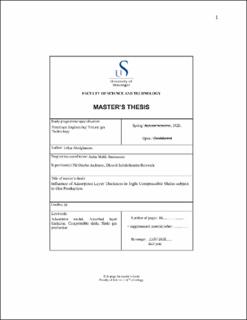Influence of Adsorption Layer Thickness in Tight Compressible Shales subject to Gas Production
Master thesis
Permanent lenke
https://hdl.handle.net/11250/2683696Utgivelsesdato
2020-07-15Metadata
Vis full innførselSamlinger
- Studentoppgaver (TN-IEP) [323]
Sammendrag
The gas transport in shale nanopores has always been a major concern in developing shale gas reservoirs. Different gas flow regimes in shale nanopores have been studied and classified during recent years. Some mathematical models have been driven to explain and simulate how shale gas reservoir performance works during gas production. In tight shales, gas is stored in both free and adsorbed forms, where the latter can make a significant part of the gas in place.
In this work, we implement an adsorption model where the adsorbed layer thickness is a function of pore geometry and dimension, total pressure, and free gas saturation. The shale is assumed to be compressible, and its porosity and pore radius may reduce because of pressure depletion. The effective pore radius, which also depends on adsorption layer thickness, is assumed to control permeability. We investigate the impact of varying adsorbed layer thickness on porosity, permeability, and overall gas recovery. Higher Recovery of shale gas is observed when we consider varying adsorption thickness compared to constant adsorption thickness. Changes in permeability due to pore geometry and dimensions show distinctly different behavior during the desorption of gas. Through a series of simulations, the most critical parameters of the system are identified.
It is concluded that the adsorbed layer thickness and compressibility of the shale matrix play an important role and should be considered in evaluating the efficiency of shale gas recovery. Overall, this work provides an intuitive modeling approach to identify the ideal scenarios for shale gas production.
Beskrivelse
Master's thesis in Petroleum engineering
